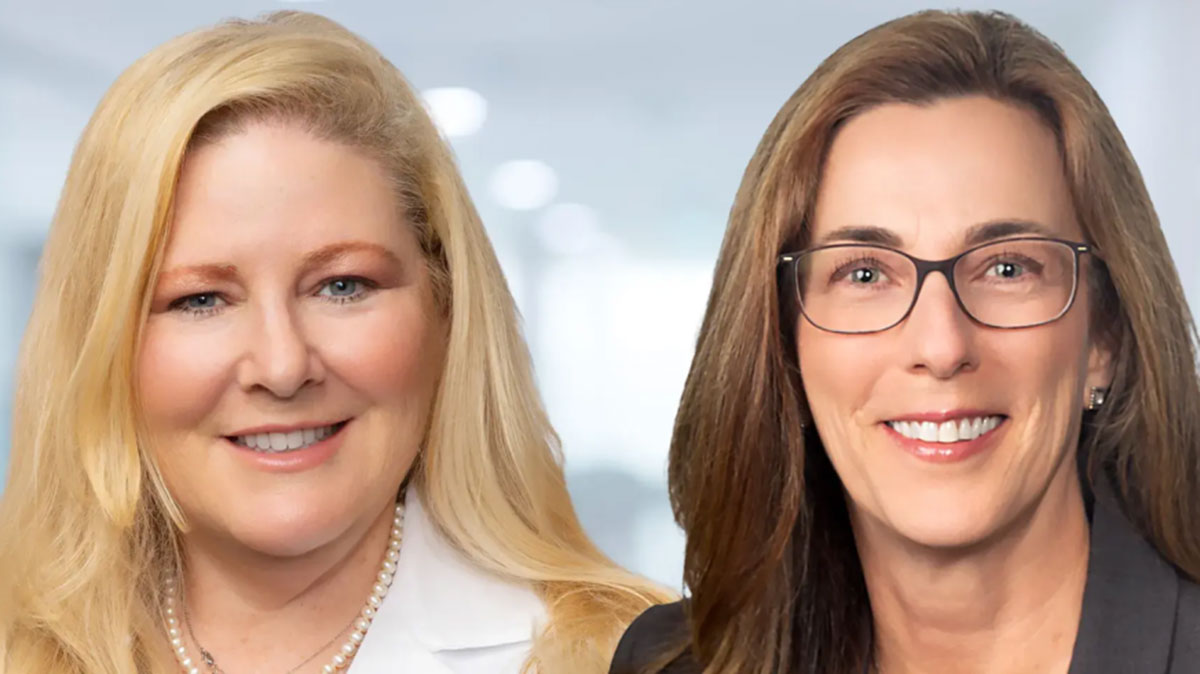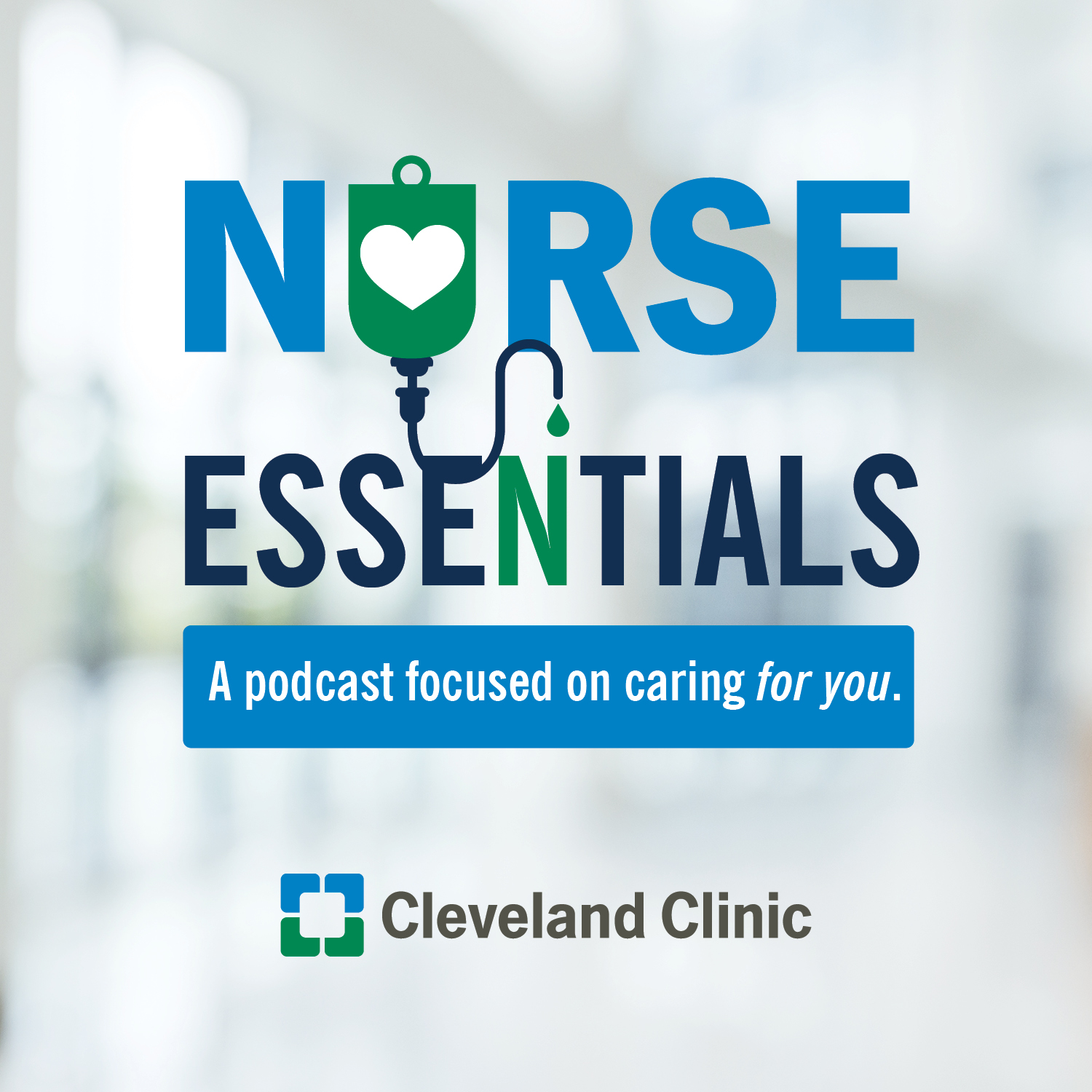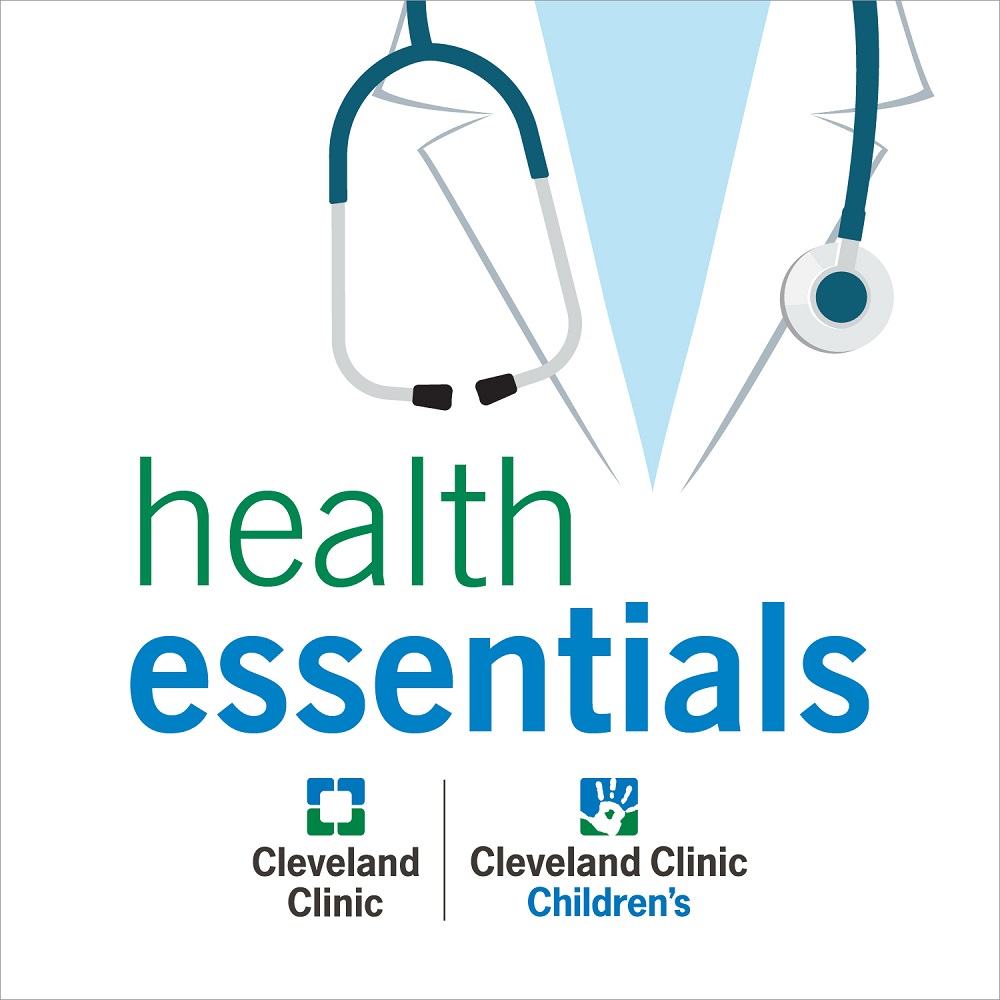Care Collaborations: RNs and LPNs Partner on Med-Surg Unit

Licensed practical nurses (LPNs) often work in long-term care facilities, but they can be valuable team members in hospitals, too. Cleveland Clinic Martin North Hospital partners RNs with LPNs on a medical-surgical unit to provide quality care to patients.
Subscribe: Apple Podcasts | Podcast Addict | Spotify | Buzzsprout
Care Collaborations: RNs and LPNs Partner on Med-Surg Unit
Podcast Transcript
[00:00:00] Carol Pehotsky: As we all continue to evolve our approaches to patient care, LPNs are a resource that are sometimes overlooked in the acute care setting. I'm joined today by Mary Richards and Julie Cianciulli from Martin North Cleveland Clinic to talk more about their successful integration of LPNs into their medical, surgical nursing care, and its benefits for the LPNs, RNs, and the patients they serve.
[00:00:29] Hi, and welcome to Nurse Essentials, a Cleveland Clinic podcast where we discuss all things nursing from patient care to advancing your career, to navigating tough on the job issues. We're so glad you're here. I'm your host, Carol Pehotsky, associate Chief Nursing Officer of Surgical Services Nursing.
[00:00:50] Welcome back everyone. Whether they're known to you as licensed practical nurses or licensed vocational nurses, LPNs and LVNs are truly a very important part of the healthcare team. And just as healthcare has and continues to evolve, so does the LPNs role, where it happens, how we utilize that, and how we utilize those caregivers to, to the top of their license and practice.
[00:01:12] If you've listened for a while, you know that even outside of work, I have several friends and family members who are nurses, including the one I'm married to. And so I was, as I was reflecting for this episode, thinking about my interactions with LPNs either professionally or, uh, outside of that.
[00:01:25] And someone in my circle, actually her training program, it, it was an associate's degree to be an RN but throughout that program it was set up that they did the coursework to become a state tested nursing assistant. And they were expected to test and pass that exam. And then they learned all the content to be a licensed practical nurse. And again, they were expected to take that licensure and pass.
[00:01:46] And so some of her classmates ejected to that point and said, I'm good to go. And then the rest of them continued on to learn the balance of the information to become a registered nurse that way.
[00:01:56] And back then before I was a nurse, and even now, I, I've always had a bit of jealousy when it comes to that because what better way to really understand how to work with all members of the team than to have done the role yourself and to have learned that as part of your schooling.
[00:02:09] For me, you know, I've, I've had the pleasure of interacting with LPNs professionally throughout my career, but I, I vividly remember one of the many things I was worried about as a new grad was, oh gosh, I don't want to ask an LPN to do something that they're not supposed to do. And I, and I, and I want them to trust me. And, and it's weird as the, as the new grad possibly delegating to somebody who's likely been an LPN far longer than I've been an RN and, and how do I develop that trust and really an understanding of their role to make sure that we can collaborate respectively to deliver care together.
[00:02:40] Well, all along those lines is my great pleasure to introduce to all of you, Mary Richards and Julie Cianciulli. Mary is a nurse manager of 44 Bed Medical Surgical Unit and a dialysis unit at Martin North Cleveland Clinic, and Julie is the director of inpatient nursing at Martin North. Ladies, thank you so much for joining me today.
[00:02:57] Mary Richards: Hi. Good, good afternoon. I'm so grateful to be here.
[00:03:00] Carol Pehotsky: So, audience are, all three of us are ladies, so we'll do our best to, to announce everybody's names so you can get to know our voices. So, Mary, I'm going to start with you. If you don't mind. Tell us a little bit about your nursing journey, how it landed you all the way here today, and where your interest in working with LPNs got peaked.
[00:03:14] Mary Richards: Sure. I started out as a CNA and then I became an LPN.
[00:03:20] Carol Pehotsky: Oh, great.
[00:03:21] Mary Richards: And then I gained my registered nurse in 2010, and then I went on to get my doctorate degree.
[00:03:27] Carol Pehotsky: Oh my gosh. So, you know, all of it.
[00:03:32] Mary Richards: Well, I, I really believe in nursing, you know?
[00:03:33] Carol Pehotsky: That's amazing. Yes. Excellent. Well, I'm definitely looking forward to hearing your expertise.
[00:03:37] And Julie, what about you? Tell us a little bit about your nursing career.
[00:03:40] Julie Cianciulli: So, at the end of this year, I will have been a nurse for 30 years. I started out as a nurse's aide here in this hospital. It's easier for, when I say about my experience, I have not been inside the OR suites. So, I've been in every other department everywhere.
[00:03:57] I have my master's degree, and I have a national certification in emergency nursing.
[00:04:02] Carol Pehotsky: Oh. You really have been everywhere. Well, if you want to come to the OR, let me know. We got you. So, I'm going to pick on you first a little bit, Mary, especially because of your professional background. So, we have audience members who could be everything from LPNs to RNs, whether they're in school or all the way through towards the end of their career.
[00:04:19] Can you share with our audience a little bit more about the LPN role, what top of licensure means, and really where that collaboration comes in between LPN and RN?
[00:04:29] Mary Richards: The licensed Practical Nurse LPNs work to the scope of their practice. They can do administration of medications, they can hang antibiotics, they can communicate with heart, which is what we practice here.
[00:04:43] Engage with the patients. Take report. They can also do assessments. And they work with the registered nurse throughout the day. So, they pretty much can do a lot of things to help support the care for all of our patients that they're not only assigned to, but also the team members.
[00:05:02] Carol Pehotsky: And it, it is important to note before we get too much further, is that, that you are both in Florida and so following state laws for Florida, our listeners of course make sure you're checking your state laws in terms of what that interaction looks like.
[00:05:14] Julie, talk to me than a little bit about it. You know that RN and LPN working together, we'll get into specifics in a moment, but just from a high level, especially all the places you've worked, how have you interacted with LPNs in the past or teams you've led to make sure that there really is that collaboration between all members of the team?
[00:05:31] Julie Cianciulli: I worked with LPNs in the past. When I first came here to Martin, she was an LPN too. So, I was very blessed that I had her. She was wonderful. So much knowledge. I was really upset when we no longer had them within the buildings. When I came on, this program was already up and running. But I love the idea.
[00:05:50] You, Mary, talked to me quite a bit about it and it's been so successful. We're actually thinking, how can we expand?
[00:05:58] Carol Pehotsky: So, speaking of that, we know that LPNs can be used in a variety of settings. We're going to spend more time talking about the inpatient setting in a moment here. But from your vantage points, Mary and Julie, where else?
[00:06:08] I've certainly interacted with LPNs even in pre-op areas, we have historically have had LPNs sometimes in PACU where they're combined with a registered nurse. We even have some locations where, especially prior to surgical technology schools coming on board, that we have lots of locations, lots of caregivers, where LPNs did the training to learn how to serve in a scrub role nurse, and are still very successful in that role.
[00:06:31] What other settings are we seeing LPNs thrive in these days?
[00:06:35] Mary Richards: They're thriving in a numerous amount of settings. I partnered with an outpatient manager, and she was able to successfully onboard the LPNs and get the RNs comfortable with it, and now it's very successful. LPNs are very good in emergency room setting as well as OR like you have stated.
[00:06:57] Wherever there's a need for patient care, I really think that if they're the team is open to it and you tell the why behind wanting to have the LPN join the team, they can be successful.
[00:07:11] Carol Pehotsky: Sure. Fantastic. And we know there's certainly a lot of need for them in long-term care facilities. But having said that, we also don't want to limit our LPN grads, uh, knowing that there are so many things that they can do.
[00:07:21] We want to make sure that the world is their oyster and we're utilizing them to the top of their license wherever they go. Exactly. So, I'm going to pick on you a little bit more, Mary, especially because of your professional travel. So, when you were in your LPN schooling and working as an LPN, reflecting back on that time.
[00:07:38] So somebody is listening and, and they've not even started any school and, and maybe in that place where they're saying, maybe I want to be an LPN or maybe I want to do something else. So specific to that thought process and decision, what are some skills and qualities that you would really recommend somebody having to go in the LPN path?
[00:07:55] Mary Richards: I think it's important to have a listening ear. Also, it's important as a leader to encourage them to go back to school, and it's also important for nowadays healthcare is, you know, you're constantly pivoting to quality or safety index or you know, patient experience. So, it's very important to also fill your own cup, have a work-life balance.
[00:08:19] I always encourage my LPNs to take advantage of all the opportunities. Here at Cleveland Clinic, we have a clinical ladder. Also, as an LPN, you're going to be expected to do your ACL S, which is important after the first year. And it’s always important.
[00:08:35] And then there's my learning has a lot of leadership classes I encourage them to take. And then also to be open to criticism because that's how we grow. It helps with your personal growth as well.
[00:08:47] Carol Pehotsky: And then I can think of it from a search tech perspective too. Not every search tech wants to be a nurse. Not every LPN wants to be a registered nurse, and so. When somebody's considering that path, what should they be thinking about in terms of, I'm working as an LPN, should I go on for additional schooling to become a registered nurse?
[00:09:04] Am I good where I'm at? What sort of things should people be considering as they're thinking about whether they want to return to school?
[00:09:11] Mary Richards: In my experience, I like to coach, mentor, and inspire people. That's my why. And I just think that they need to believe in themselves. And I think that's a big obstacle for a lot of people is fear, oh, can I do it? I have children. Can I do night shift? And you know, I just let them know anything is possible.
[00:09:32] You know, you need a mentor, you need someone that's been where you've been, and then you can see yourself in their shoes and you can see the possibilities. I think it's important for them to see the possibilities of what they can attain. And then it's important to have an organization that supports your career growth too.
[00:09:52] I mean, here at Cleveland Clinic, there's a lot of things like loan repayment, tuition reimbursement, so it helps ease the financial cost of it. But if you know you're committed, there's no telling what you can do. And you have to surround yourself with people that have already traveled those steps, you know, with mentors.
[00:10:12] Carol Pehotsky: That's right. So, Julie, thinking about all your leadership experience and your clinical experience, you know, going back to the example of your, in your life as well as mine. I'm the nurse with un Poco experience working with an LPN who, who has a wealth of experience. So what advice would you give to registered nurses working that role to, to really establish that trust and really to, to understand the swim lanes and, and where best to communicate and how to really make sure that the LPN feels like they're practicing at the top of their scope?
[00:10:41] Julie Cianciulli: Well, I think it would first have to start with education to the RNs on what their limitations are. We want them to stay within those guardrails of their licensure, but we also want them to work to the top of it also. So, I think initially it would be a lot of education and then what Mary was stating, we have to bring in some of that trust.
[00:11:04] We are bringing this in to help they can do this. So, let's think outside the box. I think sometimes we get stuck in a thought process. How can we offset some of the stress that you're feeling? And there's always, unfortunately, you know, a financial side of it.
[00:11:22] So how can we do the best of both worlds? And let's just kind of think outside the box. Okay, this is it. Let's go. Let's build that process and then build the trust with it.
[00:11:33] Carol Pehotsky: So, to build on that, these ladies are amazing experts and part of the reason they're experts is they're doing something really cool and innovative in their location to partner LPNs in their units. So, so Mary, if you wouldn't mind kicking off, tell us a little bit about the program, where the inspiration came from and, and how you've built it over the course of time.
[00:11:52] Mary Richards: Well, the LPN model of care is very exciting because there are challenges with retention and recruitment and staffing and looking to the future, making sure that we are thinking outside of the box, like Julie said, to make sure that we have the best people at the right time to provide the high quality care for our patients.
[00:12:14] So the program involves, we started small, we decided to only do it for logistics reasons. We have 26 beds and that allotted us to have one RN and one LPN that has eight patients, and then the other RNs have six patients. And so, we started small in that unit. And then how we did that is we told the why to the team.
[00:12:37] And we had a staff meeting and we explained everything and there was an uproar. You know, people are not so enthusiastic about change. We walked them through it every step of the way and we let them know, okay, this is going to be a team member that is going to be working with you, so you are going to be on the hiring end of it.
[00:12:57] So we're going to do peer interviews, and then we look to see who was more enthusiastic. We only needed two RNs, so we got two RNs that were enthusiastic about it, and we partnered them with the LPNs.
[00:13:12] And then, because sometimes schedules don't align perfectly, we started after the robust orientation period that we had with the orientating, the RN and orientating, the LPN. We started shifting it a little bit, having the LPN work with another RN that was amenable. Because after they could see them working, then they would be able to try it out.
[00:13:37] And then there was a couple of holdouts in the end, and I just had one-to-ones, and I asked what their concerns were, and we just talked, frankly, about their concerns.
[00:13:47] And I said, well, in my eyes, you really can't say this is that or the other, unless you've experienced it. And so, they were amenable to experience it. And now we have the buy-in of every RN on our unit. So much so that the night shift team is asking when we'll be hiring the LPNs.
[00:14:07] Carol Pehotsky: Well, that was actually, I had written that question. That was at nights too, and so it sounds like as soon as possible. So, these were LPNs that were new to the organization that you'd hired.
[00:14:15] Talk to me a little bit about how you wrapped them around in, in caring to make sure they didn't feel like they were coming into a hostile environment. And, and yes, it's a lot of change, but you're going to be part of that change.
[00:14:27] Mary Richards: So, our culture is welcoming. And to that point, it means not only were you invited to the dance, but someone asked you to dance at the dance. So, everybody has a shareholder in it. The techs, the TCC, which is a secretary at the desk. You know, everybody's involved.
[00:14:48] So with these teams, with the RN and LPN, we had a luncheon for them. We got gifts for the RNs. It's been a year that they've been working here, so we're going to be having a celebration for their partnership. It's very exciting.
[00:15:03] Carol Pehotsky: Have you tracked any outcomes or metrics or, or what's your sense of, certainly there's, the night shift is interested, but, but what sort of progress have you seen happen in this year's time?
[00:15:14] Mary Richards: Yes. So, we did a survey with the help of Lisa Spec. She was my partner in practice. We had weekly meetings to discuss the challenges. And also, we involved the RNs and LPNs in those weekly meetings. I think that was a foundation, you know, because we could work out the kinks.
[00:15:32] We talked about getting the job description and the scope of practice and what they can do and what they can't do. And we talked about different personalities and different scenarios, like critical scenarios, like if your patient is showing signs of a stroke, well anyone can call a stroke alert. We give them that autonomy to empower them to work their scope of practice, and for the RN to know that scope of practice as well.
[00:16:02] And it's also little details like the IV antibiotics, and you have to break the seal and mix it. The LPN cannot do that because that's mixing medications. So, it's little details that were important for everybody to be aware of, but once we were in transparency of where we are now and where we want to go.
[00:16:24] And as nurses, don't we want to give that LPN that could only get a job in a rehab coming out of school, or an LTAC or a subacute care. Don't we want to give that LPN an opportunity to work in an acute care setting like you are having that opportunity to personally grow? And do you want to be a part of that enrichment and growth of a colleague?
[00:16:50] I mean, because the success of the LPN program is completely on the team.
[00:16:56] Carol Pehotsky: You clearly are an effective leader in terms of change management. I know that you're very confident now. I'm sure it was very difficult and cheers to you for doing that hard work and bringing your team along too to help.
[00:17:06] Mary Richards: Thank you.
[00:17:07] Carol Pehotsky: So, Julie, as Mary's leader. What sort of role did you play? Did you have to intervene with any conflict? And how did you make sure that she felt supported in this innovation?
[00:17:17] Julie Cianciulli: So, like I stated earlier, unfortunately I was not here at the infancy stage or the planning stage. I came in halfway through, so it is great.
[00:17:27] Even when I would go around and round and talk to everyone, it seemed seamless. It seemed like there wasn't any of that pushback that she stated initially. It works out beautifully. I can't say enough about that program. It's really, it is exciting. She had those issues at the beginning. You do not see that now.
[00:17:46] Carol Pehotsky: That's wonderful. So, what's next for the program? We know night shift is looking for it, but what's next for Martin or the rest of our organization?
[00:17:54] Mary Richards: So, I'm talking a lot. I know my colleagues are listening and my two LPNs are going to RN school. It's the perfect scenario because they will onboard be the next partners in practice, right?
[00:18:08] And so I believe that's a discussion Julie and I have to talk about how to grow the program. You know, I full heartedly believe in it. That's something in the future that we'll have to plan.
[00:18:20] Carol Pehotsky: Well, I have, I have a feeling your phone is going to start blowing up pretty here pretty soon as this goes live. It's wonderful that your LPNs are going to RN school and confident they'll do well. In sort of my travels sometimes when that happens, then there's never a replacement of the LP N. Right? It's like, okay, now they're all RNs so we'll just Sally forth.
[00:18:38] So what are your initial thoughts on how you sustain this as a program while you celebrate those first two hires success as they move forward?
[00:18:47] Mary Richards: Right. My vision is retention, and I know that if you invest in someone that's an LPN and they, you give them experience of acute care, they're going to stay with the facility.
[00:18:58] They're very grateful to LPNs that I, you know, have the pleasure of working with. And when I do the one-to-ones, they want to stay with the facility. So, the plan is really, once they're ready to graduate, they're going to be part of the peer hiring. And, and I did tell the team I'm not hiring anyone that the team doesn't approve of.
[00:19:19] Carol Pehotsky: Nice.
[00:19:20] And that's clearly key. So, one last question and I'll ask it of both of you. So, appreciating that you come to it from different vantage points. So, we have lots of listeners from within Cleveland Clinic, but we have listeners from outside the organization. So, what advice would you give to, to nursing leaders or bedside nurses who are very intrigued thinking, I, I might want to try this in my location.
[00:19:41] What advice would you give them? What they need to start thinking about how to get some things started and what sort of lessons learned or thing to be aware of? Julie, can I pick on you first?
[00:19:50] Julie Cianciulli: Sure. So just thinking about what Mary said and what she's filling me in about the program, I would say we would need to start to prep the nurses and to point out all the advantages of what just happened and what went through.
[00:20:05] So to try to get ahead of any negativity or pushback that might start, we would have to say. Okay, so this is what we did. You do have a hundred percent say on who's coming on board. We need you to be part of this to be successful. And this, in all honesty, is another pipeline for some of the RNs. Hopefully Mary, I'm sure, would love for them to stay on their medical surgical, but maybe they were always interested in the ED or the ICU or some other areas.
[00:20:37] So we have some of our clinical technicians and unfortunately maybe there's financial issues, so maybe they could do like CT to LPN to RN. So, it's a pipeline that we want to keep open and I think that's very valuable, and Mary has proven that it is so.
[00:20:52] Carol Pehotsky: Absolutely. Mary, what would you say to somebody external to the organization thinking about starting up this kind of a program?
[00:20:59] Mary Richards: Well, I don't think I can add to what Julie said, honestly.
[00:21:03] Carol Pehotsky: Very good. Alright, well, I can't thank the two of you enough for sharing your, your experiences and your expertise with our audience. I'd love to ask each of you one parting question. Mary, you can go first. So, at Cleveland Clinic this year, as you know, we're spending a lot of time talking about our purpose and our why.
[00:21:20] So I'm hoping you'll share with our audience what's your why.
[00:21:23] Mary Richards: So, my purpose and my why is service of others. I truly believe it's a miracle to be able to come to work and do something good for someone else, and that fills my cup. I believe in education, so I am an educator as well, and I can't believe I get to do that every day.
[00:21:42] Two days are never the same. And I just feel really grateful to have great leadership like Julie. She wasn't with me the whole time, but I have to tell you, it's very beneficial to have a leader that believes in you and you can confide in and you know, really talk frank and help you work through certain issues that you need to work through.
[00:22:02] So that's my purpose. Just service of others and to be in line with an organization that's mission represents your own personal mission.
[00:22:14] Carol Pehotsky: Sure. Thank you. Julie, how about for you? What's your why?
[00:22:17] Julie Cianciulli: So, my why is I've been in leadership for a while. I took a little bit of a break to be with my mom in her last little bit of life here.
[00:22:25] But as a leader, what I enjoy is to be able to give the support that the nurse managers or whomever I'm leading, or the nurses, the support that they need to do the best they can. It's not an easy job being out on the unit. It's not an easy job running a unit. I understand that. And it's frustrating. There's certain things.
[00:22:44] My job is to make their job easier, to support them, to get them what they need. Why am I here? I'm here to support the team so we can get the best care to our patients. This is my community. You know, I grew up here. We have to provide the best care that we possibly can, and I actually, I love going around and talking to patients.
[00:23:03] I think Mary's seen me. I stop visitors in the hallway and ask if they're okay if I've seen them more than once, if I happen to pass them by outside the waiting room, our surgical and OR units. So that's my why, I like connecting.
[00:23:17] Carol Pehotsky: Wonderful. Thank you so much for joining me today, ladies.
[00:23:20] Julie Cianciulli: Thank you.
[00:23:20] Mary Richards: Thank you. Thank you so much.
[00:23:26] Carol Pehotsky: As always, thanks so much for joining us for today's discussion. Don't miss out, subscribe to hear new episodes wherever you get your podcasts. And remember, we want to hear from you. Do you have ideas for future podcasts or want to share your stories? Email us at Nurse essentials@ccf.org. To learn more about nursing at Cleveland Clinic, please check us out @clevelandclinic.org slash nursing.
[00:23:53] Until next time, take care of yourselves and take care of each other.
[00:24:00] The information in this podcast is for educational and entertainment purposes only and does not constitute medical or legal advice. Consult your local state boards of nursing for any specific practice questions.

Nurse Essentials
Nurse Essentials is a podcast about all things nursing - from tips for making your next shift easier to advice on how to handle the big challenges you face. Whether you're just starting your practice or have years of experience, we've got you covered.



